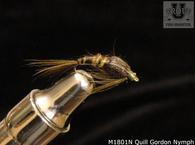
The importance of Chironomidae commonly called midges is often overlooked. Midges are very small two winged flies that resemble mosquitoes. Their lives start with eggs deposited by adults after they have mated. Midges normally hatch periodically all year around and are available as food for trout in the larvae, pupae or adult stages throughout the year. Almost all of the midge larvae and pupae are dull shades of light green, cream or red. Even the red ones are dull red.
The midge pupae are only slightly different from the larvae in appearance. They differ only because they have developed a small wing pad or fat looking darker colored section near their head. The pupae are the most important stage of life to imitate because this is what the trout focus on during a hatch. Tiny bubbles of gas provide the buoyancy that propels the midge pupae to the surface; and these bubbles are what give the pupae the appearance of glitter.
The larvae of most midge species spend their short life in the soft bottom, sand or decaying leaves and vegetation on the bottom. Trout will eat the adults on the surface, but nothing to compare with the number of pupae they eat during a hatch. Due to their tiny size, it is usually very difficult to actually see or determine if a midge hatch is underway. The light conditions have to be very favorable in order to see the hatch taking place.
If you do happen to see them hatching, fish the pupae imitations. Typically, about 60% of the trout that are caught with midge imitations are caught with the pupae imitations. Normally, it is better to fish the pupae imitation up in the water column but success can also be achieved by fishing the larvae imitation on the bottom where they change to a pupae.
For more on how to fish with midge imitations see the free on line course "Fly Fishing With Midges" at Trout University.





